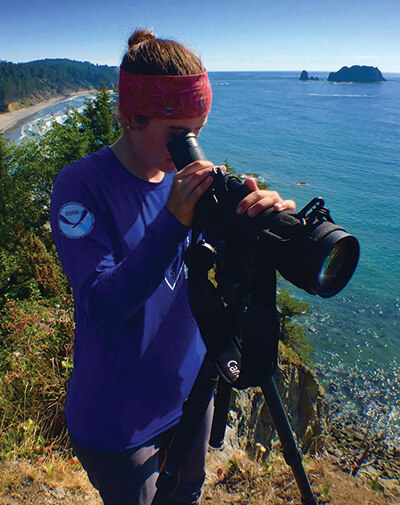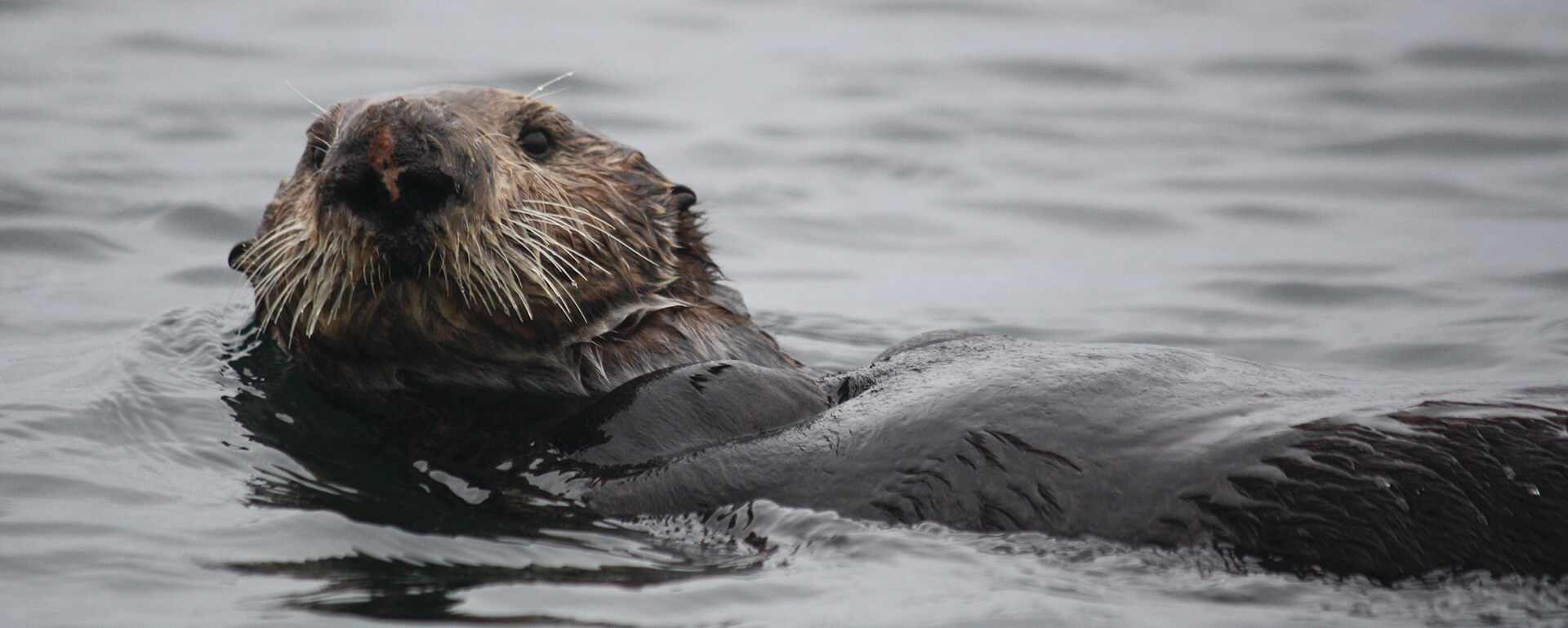Paws Up for Science
Stories from the Blue: Jessie Hale
By Elizabeth Weinberg

Jessie Hale may have the most beautiful research location in the entire world. For the past several years, the sea otter researcher and Dr. Nancy Foster Scholar has been setting up a spotting scope on a bluff overlooking Olympic Coast National Marine Sanctuary, among sword ferns, verdant moss, and Sitka spruce. Sea stacks rise from the water, cutting through early morning mist, and the ocean swell crashes on the beach below. Bald eagles fly overhead—so many it’s hard to believe they’re real. And hopefully, out in the water, sea otters dive for meals.
Hale comes out here, and to several other locations along Washington’s Olympic Peninsula, to study sea otter feeding habits. A graduate student at the University of Washington, she’s interested in what sea otters are eating and in what quantity. The data she collects will help her and other researchers understand how healthy the population along the Washington coastline is.
Washington sea otters’ lives are so mysterious in part because the outer Olympic Peninsula is incredibly remote. To get to this particular research site, Hale drives an hour from a campsite outside of the small town of Moclips onto a dirt logging road on land owned by the Quinault Indian Nation, who grants Hale a permit to research on the reservation. Roosevelt elk appear out on the road like ghosts, then disappear again into the undergrowth. Then, miles down the logging road, Hale parks on the side of the road and walks down a rough, sloping path to the bluff edge. This is one of Hale’s more accessible sites, too—most of the time, she backpacks several miles to get to her observation sites. If it takes this much effort for a dedicated researcher to find the sea otters, it’s understandable that not many people would know about them.
Though sea otters may be the unsung heroes of the coast, they’re definitely important. Sea otters are what’s known as a keystone species in coastal environments. “If you envision an arch, there’s a keystone in the middle of the arch that supports the whole thing. Without the keystone, the whole arch collapses,” Hale explains. That’s because sea otters eat invertebrates, particularly sea urchins. Left unchecked, sea urchins will devour all the kelp in an area; with sea otters eating the urchins, the kelp grows into lush forests that provide habitat for all kinds of creatures. “It’s the difference between a homogenous environment with primarily sea urchins, versus a very diverse marine ecosystem,” she says.
The Dr. Nancy Foster Scholarship gave me the freedom to do the science that I wanted to do.
But for years, sea otters didn’t exist on the Washington coastline. They were hunted to local extinction in the early 20th century, valued for their thick, soft fur. In 1969 and 1970, researchers reintroduced 59 sea otters from Alaska to the Olympic Coast. In the decades since, the sea otter population has grown: now more than 2,000 sea otters live in Washington, most of them in waters protected by Olympic Coast National Marine Sanctuary.
Because of their habitats’ remoteness, these otters haven’t been well-studied since they were transplanted, and Hale is working to change that. At her study sites, she logs what sea otters eat, how long they take to find their prey, and how much time they spend on the surface eating. These observations help her understand if the otters are getting enough food to survive and what prey they’re preferring. “Based on how much food there is available in the environment,” she explains, “there are only so many otters that can successfully survive and reproduce in an area.” Knowing how much sea otters are eating can help Hale understand whether the population may soon be leveling off.
Olympic Coast National Marine Sanctuary plays a key role in this equilibrium, says Hale. The National Marine Sanctuary System “prioritizes the Olympic Coast as a special place that we care about and want to keep healthy. Sea otters are an important piece of that.” Plus, she points out, the sanctuary helps raise awareness about sea otters, so that future conservationists and scientists alike will grow up knowing that Washington is home to a thriving population of these adorable, and important, animals.
The Dr. Nancy Foster Scholarship has been key to Hale’s research. It “gave me the freedom to do the science that I wanted to do,” she says. She was able to come up with the topic for her research and has undertaken the data collection and analysis herself. After she finishes her Ph.D., she’d like to continue with her work helping sea otters and other marine predators that need conservation support. “There are a lot of questions that need to be answered” about marine mammals, Hale says, and she’d like to be the one to answer them.


